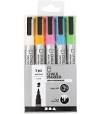The Art of Miniature Painting: A Timeless Tradition
Miniature painting is a delicate and intricate art form that has captivated audiences for centuries. Originating in ancient civilizations, miniature painting has evolved into a revered artistic tradition that continues to thrive in the modern world.
History and Origins
The history of miniature painting can be traced back to ancient cultures such as the Mughal Empire in India, Persia, and medieval Europe. These miniature artworks were often created on a small scale using fine brushes and meticulous attention to detail. The intricate designs and vibrant colors of these paintings served as a visual feast for the eyes.
Techniques and Materials
Miniature painting requires precision and patience, as artists work with tiny brushes to create intricate patterns and designs. Traditional materials used in miniature painting include natural pigments, gold leaf, and handmade paper. The use of these high-quality materials ensures that each artwork is not only visually stunning but also durable and long-lasting.
Themes and Subjects
Miniature paintings often depict scenes from mythology, folklore, nature, or daily life. Artists use their creativity to bring these subjects to life on a small canvas, showcasing their storytelling abilities through intricate details and expressive characters. The themes explored in miniature paintings reflect the rich cultural heritage of the regions where this art form thrives.
Modern Revival
In recent years, there has been a resurgence of interest in miniature painting as artists seek to preserve this traditional art form while infusing it with contemporary influences. Modern miniaturists are experimenting with new techniques and styles, blending the old with the new to create innovative artworks that appeal to a diverse audience.
The Beauty of Miniature Art
Whether displayed as standalone pieces or part of a larger collection, miniature paintings exude charm and elegance. Their small size invites viewers to take a closer look, appreciating the intricate details and craftsmanship that go into each artwork. Miniature art serves as a testament to the skill and dedication of talented artists who continue to keep this timeless tradition alive.
Essential Tips for Mastering Miniature Painting: A Guide to Achieving Flawless Results
- Start with a clean and well-primed miniature for better paint adhesion.
- Thin your paints with water or medium to achieve smoother layers and avoid obscuring details.
- Use a variety of brush sizes for different tasks, such as base coating, detailing, and dry brushing.
- Practice good brush control to improve precision and avoid mistakes.
- Finish your miniature with a protective varnish to preserve the paint job.
Start with a clean and well-primed miniature for better paint adhesion.
To achieve optimal results in miniature painting, it is essential to begin with a clean and well-primed surface. Properly priming the miniature not only ensures better paint adhesion but also creates a smooth and even base for painting. By starting with a clean canvas, artists can enhance the vibrancy of colors, improve paint durability, and achieve more precise detailing in their artwork. This foundational step sets the stage for a successful painting process and helps artists create high-quality miniatures that stand out for their visual appeal and longevity.
Thin your paints with water or medium to achieve smoother layers and avoid obscuring details.
To enhance the quality of your miniature paintings, it is advisable to thin your paints with water or a suitable medium. This technique allows for smoother application of layers, ensuring that intricate details remain visible and vibrant without being obscured by thick paint. By diluting your paints effectively, you can achieve a more refined and professional finish in your artwork, enhancing the overall aesthetic appeal and depth of your miniature masterpiece.
Use a variety of brush sizes for different tasks, such as base coating, detailing, and dry brushing.
When engaging in miniature painting, it is essential to utilize a range of brush sizes to effectively tackle various tasks involved in the process. Different brush sizes serve specific purposes, such as base coating, detailing, and dry brushing. A larger brush may be ideal for applying base coats and covering larger areas with ease, while a smaller brush allows for intricate detailing work that demands precision and control. Dry brushing, on the other hand, requires a specialized brush with stiff bristles to achieve subtle highlights and textures on the miniature surface. By employing a variety of brush sizes strategically, artists can enhance their painting techniques and bring out the finest details in their miniature artworks.
Practice good brush control to improve precision and avoid mistakes.
To enhance precision and prevent errors in miniature painting, it is crucial to practice good brush control. Mastering the art of handling fine brushes with steady hands allows artists to execute intricate details with accuracy and finesse. By honing their brush control skills, artists can achieve greater control over their strokes, resulting in precise lines, delicate shading, and flawless detailing in their miniature artworks. Consistent practice and attention to brush control not only improve the overall quality of the painting but also contribute to the artist’s growth and proficiency in this meticulous art form.
Finish your miniature with a protective varnish to preserve the paint job.
To ensure the longevity of your miniature painting, it is essential to finish it with a protective varnish. Applying a coat of varnish not only enhances the colors and details of the paint job but also acts as a barrier against dust, moisture, and other environmental factors that can damage the artwork over time. The varnish not only preserves the beauty of the painting but also adds a professional touch, making your miniature artwork look polished and well-maintained for years to come.




